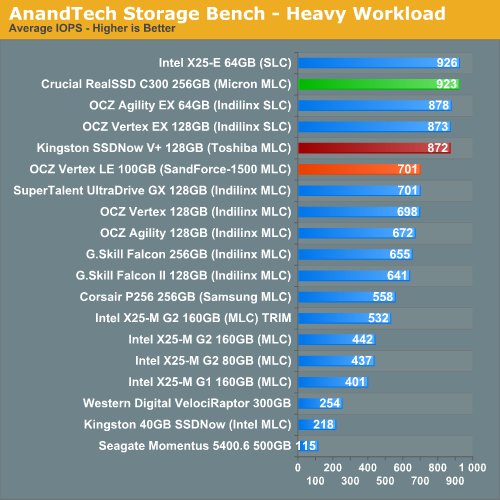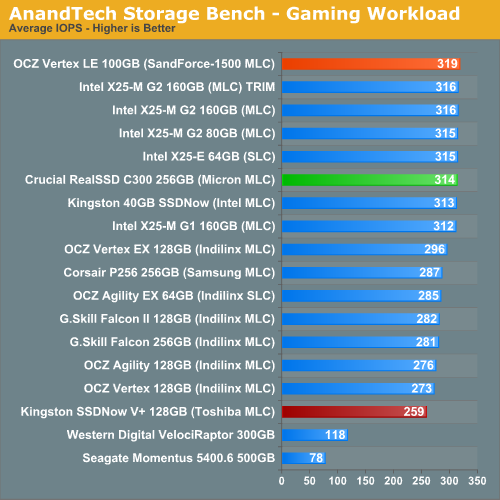OCZ’s Vertex Limited Edition Review & SSD State of the Union
by Anand Lal Shimpi on February 19, 2010 12:00 AM EST- Posted in
- Storage
AnandTech Storage Bench
Note that our 6Gbps controller driver isn't supported by our custom storage bench here, so the C300 results are only offered in 3Gbps mode.
The first in our benchmark suite is a light usage case. The Windows 7 system is loaded with Firefox, Office 2007 and Adobe Reader among other applications. With Firefox we browse web pages like Facebook, AnandTech, Digg and other sites. Outlook is also running and we use it to check emails, create and send a message with a PDF attachment. Adobe Reader is used to view some PDFs. Excel 2007 is used to create a spreadsheet, graphs and save the document. The same goes for Word 2007. We open and step through a presentation in PowerPoint 2007 received as an email attachment before saving it to the desktop. Finally we watch a bit of a Firefly episode in Windows Media Player 11.
There’s some level of multitasking going on here but it’s not unreasonable by any means. Generally the application tasks proceed linearly, with the exception of things like web browsing which may happen in between one of the other tasks.
The recording is played back on all of our drives here today. Remember that we’re isolating disk performance, all we’re doing is playing back every single disk access that happened in that ~5 minute period of usage. The light workload is composed of 37,501 reads and 20,268 writes. Over 30% of the IOs are 4KB, 11% are 16KB, 22% are 32KB and approximately 13% are 64KB in size. Less than 30% of the operations are absolutely sequential in nature. Average queue depth is 6.09 IOs.
The performance results are reported in average I/O Operations per Second (IOPS):

Under a typical, light poweruser workload, the Crucial RealSSD C300 bests OCZ's Vertex LE by 4.5% - not a tangible difference, just a (barely) measurable one. Intel's SLC X25-E is actually still the fastest thing here, which must be frustrating for Intel since the only thing separating the G2s from topping the charts is sequential write speed.
The Toshiba based Kingston drive performs similarly to the MLC based Indilinx drives, which is good since that's exactly where it's supposed to perform.
If there’s a light usage case there’s bound to be a heavy one. In this test we have Microsoft Security Essentials running in the background with real time virus scanning enabled. We also perform a quick scan in the middle of the test. Firefox, Outlook, Excel, Word and Powerpoint are all used the same as they were in the light test. We add Photoshop CS4 to the mix, opening a bunch of 12MP images, editing them, then saving them as highly compressed JPGs for web publishing. Windows 7’s picture viewer is used to view a bunch of pictures on the hard drive. We use 7-zip to create and extract .7z archives. Downloading is also prominently featured in our heavy test; we download large files from the Internet during portions of the benchmark, as well as use uTorrent to grab a couple of torrents. Some of the applications in use are installed during the benchmark, Windows updates are also installed. Towards the end of the test we launch World of Warcraft, play for a few minutes, then delete the folder. This test also takes into account all of the disk accesses that happen while the OS is booting.
The benchmark is 22 minutes long and it consists of 128,895 read operations and 72,411 write operations. Roughly 44% of all IOs were sequential. Approximately 30% of all accesses were 4KB in size, 12% were 16KB in size, 14% were 32KB and 20% were 64KB. Average queue depth was 3.59.

I ran and re-ran the tests - they're accurate. The Vertex LE does well, just not as good as the Kingston or Crucial drives here. The Crucial RealSSD C300 is simply a beast in our write-heavy test. I suspect that the fact that many of our writes here are compressed is to blame for the Vertex LE not being as fast as usual here. Remember that SandForce's architecture works by data reduction, whether through compression, deduplication or other similar natured algorithm. By definition those algorithms don't work well on data that is already being written in reduced form. If you're dealing with a lot of compressed archives, the Vertex LE will perform well, but not as well as the RealSSD C300.
Our final test focuses on actual gameplay in four 3D games: World of Warcraft, Batman: Arkham Asylum, FarCry 2 and Risen, in that order. The games are launched and played, altogether for a total of just under 30 minutes. The benchmark measures game load time, level load time, disk accesses from save games and normal data streaming during gameplay.
The gaming workload is made up of 75,206 read operations and only 4,592 write operations. Only 20% of the accesses are 4KB in size, nearly 40% are 64KB and 20% are 32KB. A whopping 69% of the IOs are sequential, meaning this is predominantly a sequential read benchmark. The average queue depth is 7.76 IOs.

Just as we saw with our PCMark tests, all of the drives perform about the same here. If you're just going to be tossing games on your SSD, you can't really go wrong with any of these drives. It's possible that if we were able to use our 6Gbps controller here that Crucial would break the mold as the drives here appear to be limited by sequential read speed.










83 Comments
View All Comments
anikolayev - Friday, February 19, 2010 - link
I just bought an OCZ Agility based on your benchmarks, the ones suggesting the drive is capable of 160MB/s writes. However it has been confirmed by several other customers that the current batch being shipped by NewEgg uses different chips in the OCZ lottery which comes up with 100-130MB/s writes. This is very significant for people buying this drive for video capture related purposes, since 100 is hardly any better than the average 70 on a standard HDD.The Agility's random writes that you show in the charts and latest article are also almost double of the drives being shipped right now. After countless tweaks I can barely do 7MB/s, forget 12.
I understand the Agility is a dated drive, but it's still very popular due to recent sales ($130 for 60GB) and I think it would help your readers to take a look at updated performance numbers that are more realistic to what they will actually get.
Also there's no refunds with SSDs, so anyone buying into these charts will just have to live with what they get.
v12v12 - Tuesday, February 23, 2010 - link
FYI... 100 vs 70 is THIRTY PERCENT FASTER DUH? 30% is HUGE in regards to technological competition/advancements. Where have you been all these years? Show us a 30% performance gain (aside from SSD beta testing and new releases) in 1-2 mechanical HD generations... Umm you CAN'T>.<AnnonymousCoward - Tuesday, February 23, 2010 - link
> FYI... 100 vs 70 is THIRTY PERCENT FASTER DUH?Duhhh it's 43% :)
hardwareguy - Saturday, February 20, 2010 - link
If you want and SSD that's fast and cheap the agility is hard to beat. If that last bit of performance is important you can buy one of the vertex turbos or an intel drive but it quickly gets un-cheap. Even a 3/4 speed agility is still 10x better than a spinning metal drive.Anand Lal Shimpi - Saturday, February 20, 2010 - link
Hmm, what size drive do you have? I tested the 120GB Agility I believe which has higher read/write specs than the rest.Take care,
Anand
bji - Friday, February 19, 2010 - link
They've admitted that they are building only a limited number of drives, so how will they honor the three year warranty? It's unlikely they will be able to replace a dead drive with another OCZ Vertex Limited Edition, since there won't be any more. Will they replace with an equivalent drive? If so, what would the equivalent drive be?I continue to be skeptical of SandForce's controller technology. I would be interested in seeing some more rigorous testing done on these drives, such as repeated and random simulated power outages during writes, to ensure that the drive doesn't brick itself if power is lost at an inopportune time (especially as this version does not have the supercap).
Exelius - Wednesday, February 24, 2010 - link
Typically what they would do is either hold back a percentage of production for warranty replacements. Once they run through these they'd just offer you an equivalent current product.LazerFX - Friday, February 19, 2010 - link
Someone's not read the article...From the "Final Words" page, reproduced here so that anyone else reading the first few pages can get the answer:
"If you’re willing to take the risk, the Vertex LE appears to be the best SSD you can buy at $399. It is a difficult proposition simply because we have had such limited experience with the drive and the controller/firmware have a completely unproven track record. It really boils down to how much of an early adopter you are. At least OCZ as a company tends to take care of its customers, so even if you do take the jump and something does go wrong you won’t be SOL. The Vertex LE will ship with a 3 year warranty and if your drive dies you'll get another LE (OCZ is putting some aside), Vertex 2 or other equivalent in its place.
OCZ’s CEO Ryan Petersen and I could always get into another yelling match if you aren’t taken care of."
So... there you go.
Kibbles - Saturday, February 20, 2010 - link
even if they run out of those they put aside. they still have the enterprise versions.bji - Friday, February 19, 2010 - link
Absolutely right, my answer was there and I posted before reading all the way to the end. Mea culpa.